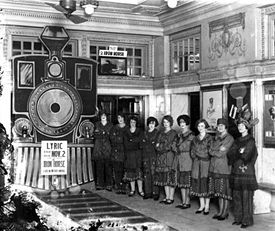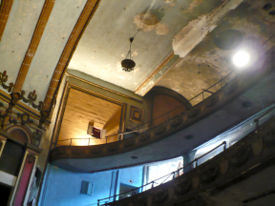Lyric Theatre: Difference between revisions
(→Opening: we'll assume that was a typo) |
|||
| Line 40: | Line 40: | ||
==References== | ==References== | ||
* "[http://bplonline.cdmhost.com/u?/p4017coll2,1520 Lyric to open with pictures]" (April 24, 1932) ''Birmingham News'' - via Birmingham Public Library Digital Collections | |||
* "A Lyrical Development." (June 1993) ''Black & White'' | * "A Lyrical Development." (June 1993) ''Black & White'' | ||
* Hollis, Tim (August 16, 2006) "[http://www.birminghamrewound.com/features/bhamtheaters_part2.htm Showplaces of the South, Part 2]." Birmingham Rewound. Accessed July 10, 2008. | * Hollis, Tim (August 16, 2006) "[http://www.birminghamrewound.com/features/bhamtheaters_part2.htm Showplaces of the South, Part 2]." Birmingham Rewound. Accessed July 10, 2008. | ||
Revision as of 11:44, 13 June 2010

The Lyric Theatre is a former vaudeville and movie theater located at 1800 3rd Avenue North on the corner of 18th Street North.
During its peak in the late 1910s and early 1920s, the Lyric hosted major touring shows under the B. F. Keith Big Time Vaudeville banner. In later years the theatre was used for cinema screenings, mostly second-run and alternative releases. It is the only surviving vaudeville theater in Birmingham.
Vacant since the late 1970s, the structure is currently owned by Birmingham Landmarks and fund-raising is underway for an extensive preservation and renovation effort.
History
Opening

The development of the Lyric Theatre began when real-estate developer Louis V. Clark purchased three adjoining lots and hired the Hendon Hetrack Construction Company to construct a six-story office building and theatre on the property. Clark formed a partnership with Jake Wells to operate the theatre. Wells already owned and managed a number of theaters across the South, including the Bijou Theatre a block west.
The Lyric originally had approximately 1,192 seats spread across the main floor and two, steep balconies, plus two opera boxes. A gold-leafed and painted asbestos curtain hung on the stage beneath a proscenium featuring a large mural known as The Allegory of the Muses, which was painted by local artist Harry Hawkins. Beneath the stage are a series of dressing rooms, each about eight square feet with sinks in the corners.
The Lyric opened to the public with a performance headlined by cartoonist Rube Goldberg on January 14, 1914. The opening followed a brief legal dispute with the owners of the Orpheum Theatre for the rights to host shows on the B. F. Keith Big Time Vaudeville circuit.
By 1924 the theater was operated by "The Lyric Company", a Dallas, Texas-based enterprise headed by Karl Hoblitzelle. It was affiliated with the Orpheum Circuit, B. F. Keith's circuit, United Booking Offices of America, Hoblitzelle's Interstate Amusement Company, and the Western Vaudeville Manager's Association. W. S. Crosbie was the local manager in charge, wtih Al Plante as musical director of the Lyric Wonder Orchestra. Daily performances were scheduled for 2:30, 7:15 and 9:10, with two matinees (1:15 and 3:15) on Saturdays. Under Hoblitzelle's orders, all performances were guaranteed to be free of offensive words, expressions and situations.
Until the completion of the Ritz Theatre in 1926 the Lyric was the grandest Vaudeville hall in Birmingham. Stars such as Sophie Tucker, Gus Edward's Kid Kabaret with George Jessel and Eddie Cantor, Will Rogers, the Keaton Family Acrobats (with Buster Keaton), Milton Berle, Fred Allen, Jack Benny, Belle Baker and Mae West appeared on stage.
Heyday
The heyday of the Lyric Theatre was short-lived. In the late 1920s the Lyric hosted locally-produced plays staged by the Favorite Players repertory company. On Sunday evenings the theatre was used by the newly-formed Independent Presbyterian Church. A Kilgen opus 3459 size 2/4 theater organ was installed in 1925.
The Lyric continued to operate successfully up until the Great Depression. With his funds overextended, Wells lost his chain of theaters and ultimately committed suicide. Ownership of the Lyric reverted to the mortgage company which leased it to the Schubert organization. The Lyric continued to present vaudeville acts, but the Depression and competition from movies and radio led to its decline and closure in 1930 or 1931.
In 1932, brothers Ben and L. A. Stein of Jacksonville, Florida reopened the Lyric as a movie theater. They installed a new Western Electric sound system and other refurbishments and scheduled four feature films each week, beginning with Will Rogers in "A Connecticut Yankee in King Arthur's Court" on April 25 of that year. Ben returned to Florida while his brother remained in Birmingham as manager.
In 1935, the Waters family of Birmingham bought the Lyric and ran it as a second-run movie house with occasional live performances. Gene Autry and Roy Rogers both appeared there in the 1950s. The opera boxes were removed in that decade to accommodate wide-screen films. The theatre closed its doors again in 1958. The adjoining office building, however, remained active with businesses such as the House of $8.50 Eyeglasses.
Later life
In 1972, friends and old movie buffs Dee Sloan and Robert Wharton reopened the Lyric as the Grand Bijou, showing classic movies. The Bijou lasted only a short time. A couple of years later, it reopened as the Foxy Adult Cinema and later the Roxy Adult Cinema, before closing again for good in the early 1980s.
In 1975, the Lyric's twin fire escapes on 18th Street North were populated by bodybuilders posing for the final scene of Stay Hungry.
In 1993, the Waters family donated the building to Birmingham Landmarks, a nonprofit organization which had taken ownership of the Alabama Theatre across the street from the Lyric a few years earlier. Although the theater itself has not been used since the 1970s, the adjoining office building houses operating retail spaces at street-level along 3rd Avenue, including Lyric Hot Dogs and Place Design Studio. The interior is currently in disrepair and has no climate control system, leading to further deterioration. Birmingham Landmarks is currently trying to raise the $20 million that the theater's restoration is estimated to cost.
The City of Birmingham has given $200,000 to study what it would take. In early 2009, Birmingham Landmarks began planning to renovate the lobby to showcase the potential of the theatre's renovation. A few public open-house events were held in advance of the primary fundraising drive to broaden public interest in the venue.
References
- "Lyric to open with pictures" (April 24, 1932) Birmingham News - via Birmingham Public Library Digital Collections
- "A Lyrical Development." (June 1993) Black & White
- Hollis, Tim (August 16, 2006) "Showplaces of the South, Part 2." Birmingham Rewound. Accessed July 10, 2008.
- Chambers, Jesse (July 3, 2008) "The voice of the theatre." Birmingham Weekly
- Tomberlin, Michael (January 4, 2009) "Push continues for new projects in Birmingham's theater district." Birmingham News
External links
- The Lyric Theatre website
- Photos of the Lyric in the Magic City Flickr Group


